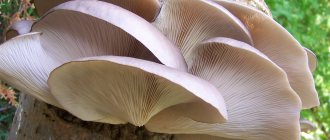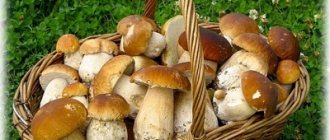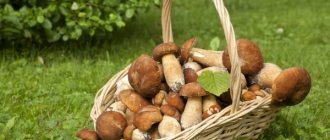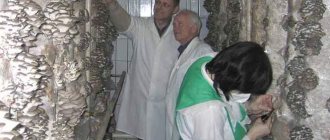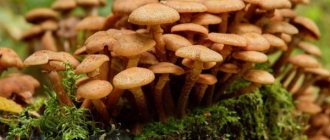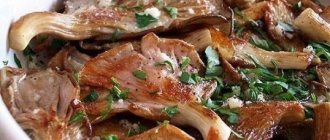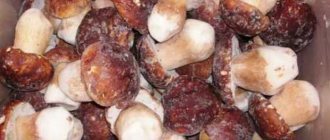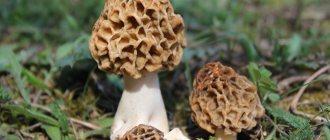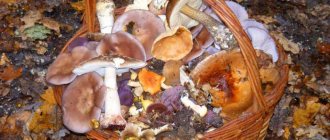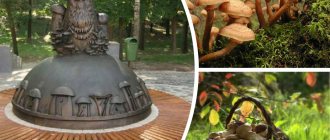- October 10, 2019
- Man in the wild
- Victoria Stitch
Mushroom lovers are looking forward to the time to go for their favorites. Such a hobby remains for life and cannot but rejoice. Even when it’s not the picking season, the mushroom picker’s eye still runs through the bushes and under the trees in search of a barely noticeable cap or white stem. An eternal question that worries all avid mushroom pickers: how to pick mushrooms correctly: cut or tear? Any trip for mushrooms turns into a pleasant walk and pastime. In this article we will look at how to pick mushrooms.
Legends about mushroom picking
Usually our childhood was somehow connected with going to the forest to pick mushrooms. This could be a trip with the whole family or a trip for two or three people. Those leading such an “event” often said that mushrooms should not be picked, but only cut with a knife. Otherwise, not a single mushroom will ever grow in this place again. After all, the mycelium underground will be damaged. But in order not to be afraid of different opinions, it is important to know how the mushroom and its mycelium work. Then you can answer the question of how to pick mushrooms correctly: cut or tear. Let's get acquainted with the opinion of representatives of science.
Where to look for mushrooms
Although mushrooms can be found in many and varied places, there are two main types of habitat that most mushroom hunters target: grasslands and forests.
Pasture basically means grassy areas. The best fields are those used for year-round grazing of animals (farmed or wild). The animals keep short grass, which the mushrooms prefer, and also fertilize the soil. Natural land that is used to grow hay is not as productive (for mushrooms) due to tall grass and disturbance caused by heavy machinery.
You can see mushrooms from space, Honestly! Well, not the mushrooms themselves, but the rings that some species form (for example, champignons). These rings are clearly visible on satellite imagery, so you can pick out likely fields to visit while sitting at your computer (just don't tell your boss we suggested this to you). Satellite imagery can also tell you whether an area of forest on a map is coniferous or deciduous. This is useful if you are looking for species that grow with certain trees.
Many mushrooms, and indeed most edible species, prefer forest areas. This could be a small grove or the middle of a forest. Some of the forest mushrooms grow on decaying leaf mats on the forest floor, while others have a direct connection to the trees they grow under. Many types of mushrooms grow only in association with certain types of trees. Therefore, forests dominated by preferred tree species are likely to be more productive. Trees that are good for mushroom hunting include: beech, oak, birch, pine.
Most edible mushrooms are symbiotic and grow near certain plants and trees. Mixed forests with deciduous and pine trees are ideal. The more types of trees, the more types of mushrooms you will find
What do scientists say: cut mushrooms or twist them?
There is a lot of controversy between mushroom pickers. Everyone wonders whether they are picking mushrooms correctly and whether they are causing harm to nature. Some people believe that the twisted mushroom damages the mycelium, while others say that after cutting off, the remaining part rots and damages the mycorrhiza.
Scientists are revealing useful information about whether to cut or pick mushrooms. Even in such an ancient method of gathering, you need to get your food using your mind. According to scientists, when cutting, an infection can get on the cut, which will spread further to the mycelium, and it will get sick. And if you pull it out, the mycelium itself may be damaged. Therefore, scientists are in favor of twisting the mushrooms and cutting off the dirty part of the stem.
Rules for cleaning stems and caps at home
Mushrooms require a certain attitude. You won’t be able to bring several buckets of mushrooms from the forest and forget about them for 3 days, because this is a perishable product. And if there are worms in some mushroom, then other specimens lying nearby will quickly deteriorate. To clean mushrooms faster, you need to follow simple steps.
- Sort them by variety. After all, they are cleaned differently. If there are no problems with whites, then, for example, with boletus, you will have to suffer.
- Place into different piles those that we are going to fry for dinner and those that are intended for winter preparations. It is better to cook the mushrooms within 3-4 hours after picking so that they do not have time to spoil.
- Some types of mushrooms quickly darken in a warm room, so they need to be placed in a well-ventilated place, for example, out on the balcony. They can also be soaked in salted cold water.
- Wash mushrooms intended for salting, pickling, frying and boiling under running water. Do not wash boletus mushrooms, honey mushrooms, champignons: just wipe them with a damp cloth.
- After the mushrooms have been in the water for some time, small forest inhabitants - worms - begin to emerge from them. It is useless to wash them out of the cap; it is better to throw them away immediately or give them to the chickens to eat, if there are any on the farm. If only the leg or individual small areas are damaged by wormholes, they can be cut off.
- You can go over particularly dirty areas of the hats with a soft-bristled brush. We will not scratch the cap in this way, but will remove adhering earth or sand.
- If the soil cannot be cleaned off, it can be cut off with a knife. The stems of the mushroom should be scraped a little to get rid of the soil.
- To quickly clean the mushroom, you need to dry it after washing. You can spread clean redheads, chanterelles, and milk mushrooms on a waffle towel so that the moisture comes out of them faster. It is better to place the oils on a wooden surface, as moisture makes them slimy.
- Do not wash mushrooms that we plan to dry for the winter. You need to brush off the debris and cut the mushroom into pieces.
So that mushrooms can be cleaned faster, it is worth sorting them
Structure and types of mushrooms
Basically, the mushroom has an aboveground and underground part. The aboveground part includes the fruiting body - this is the cap and the stem, what we see when picking mushrooms in the forest. The underground part consists of mycelium (mycelium). When the fruiting body is torn off, the mycelium remains in the ground, it breaks off only in the place where it turns into the stem, so whether the mushroom is cut or twisted does not matter. The rotting process does not begin. But there is one peculiarity in such doubts among mushroom pickers, and it arose on the basis of the different structure of mushrooms. To answer whether to cut or twist mushrooms correctly, let’s look at the structure of different mushrooms. So, what do you need to know if we are collecting different types of mushrooms?
Mycorrhizae are a union of fungi
The fact is that the fruiting bodies formed from the plexus of terminal hyphae “grow” where there are a lot of nutrients for the fungus. And they are in abundance around shrubs and trees - after all, all higher mushrooms enter into peculiar alliances with them (or rather, with their roots), called mycorrhizae.
During the formation of mycorrhiza, the hyphae of the mycelium entwine the root hairs, and sometimes even penetrate into the thickness of the roots themselves. Thanks to this, the fungus and plant exchange different substances with each other. The mushroom supplies the tree with water and mineral elements, which it extracts in places where the root cannot reach. And the plant, in turn, supplies its ally with carbohydrates, which cannot be found in the soil.
You understand that since the area where mycorrhiza is formed has the most nutrients, the fruiting bodies will always appear only there, no matter what you do with them - pick or cut them. In order for them to stop growing in their usual places, you need to cut down the tree and uproot the roots. Only then will the fungus, having lost the “free cafe”, look for another place to form fruiting bodies (and it will be in the area of the next mycorrhiza).
How to pick mushrooms correctly depending on the type: cut or tear
However, depending on the type of mushroom, there is still a more preferable collection method.
Tubular mushrooms with thick stems (white mushrooms, aspen mushrooms, boletus mushrooms, boletus mushrooms) are best twisted. When cut, part of the stem remains in the ground, because in such mushrooms it is half buried. Honey mushrooms, champignons, russula, umbrella mushrooms and chanterelles are best cut off. These mushrooms are lamellar, and the stem can simply crumble.
The largest creature in the world is a mushroom!
By the way, sometimes myceliums are simply gigantic. Did you know that the largest living creature in the world is a mushroom, and not an elephant, whale or diplodocus? And this mushroom is alive and well in Malheur National Park in the Blue Mountains (Oregon, USA). Its mycelium covers an area of 890 hectares, which is comparable to the size of 1220 football fields.
Honey mushroom: what is it?
This mushroom belongs to the species Armilaria ostoyae, also called honey mushroom. Outwardly, it looks like an ordinary honey mushroom. Every year, millions of fruiting bodies of this giant appear on the stumps and trees of the park - and this has been going on for at least 2,400 years. And no matter how much you tear them with your hands or cut them with knives, you cannot cause any harm to the super mushroom. True, no one does this, since Armilaria ostoyae belongs to the category of inedible mushrooms.
So, no matter how much you tear the fruiting bodies
- white,
- boletus
- and boletuses,
they will still grow again next year in the same places. But why is this happening?
How to properly cut mushrooms
Mushrooms are cut with a knife as close to the base as possible. In this case, the second hand supports the leg or cap. Before cutting, you need to evaluate the ripeness of the mushroom. Old mushrooms do not need to be cut off; they have already accumulated toxic substances and insects. But the young, small ones must be left to grow up. Do not trample or knock down mushrooms that do not fit. It is better to hang the mushroom on a tree; it will dry out and be eaten by an animal passing by. Also, if the mushroom is sick, then when it touches shoes, the infection will spread throughout the forest and infect other myceliums.
A mushroom weighing 514 kilograms was found
Sometimes, when there is an abundance of nutrients, the fruiting bodies grow huge. Thus, two years ago, Chinese biologists found a tree tinder fungus in Fujian province, whose fruiting body is recognized as the largest in the world: its weight was 514 kilograms with a cap volume of 524 thousand cubic centimeters. It is impossible in principle to pick such a mushroom, and in order to cut it, you will need not a knife, but a chainsaw - the tissues of the mushroom are so sclerotized that its hardness is not inferior to the tissues of the tree on which it grew.
Preparing for collection
If you are going for mushrooms for the first time, look at a map of the area. Find out where the nearest mushroom spots are. Learn to navigate using a compass. It is advisable to walk into the forest along highways or railways so that there is a constant reference point. There is no need to go very deep into the forest.
A phone with GPS and a charged battery will come in handy. You need to remember how you entered the forest and what the terrain was like. Along the way, notice additional landmarks. If you enter the forest from the south, then you need to exit to the north. If you plan to go deeper into the forest, do it only when you have a group of mushroom pickers with you. You can attach brightly colored cloths so as not to lose your way.
To have a successful mushroom picking trip, you need to be well prepared. Find out the weather from official sources or according to folk signs. When the weather is expected to be clear, the sun will be bright red at sunset. At night you can see the stars in the sky. The dew dries out quite quickly. If cloudy or rainy weather is expected, then crows may fly high, the clouds are low. In any case, you need to go early in the morning, while the sun's rays have not yet filled the forest. This will make it easier to see hidden pets.
If you get lost, you need to listen and move in the direction of the sound of water or noise from the road. When you reach a body of water, keep moving along the shore, as rivers flow into large bodies of water and there may be people not far from them.
Mushroom picker calendar
The end of summer and the beginning of autumn is the mushroom season in full swing, but for true lovers it is not limited to two months. Long-term observations have revealed a seasonality in the mass appearance of certain species, which can be superimposed on a calendar grid. As a result of this manipulation, you will get a mushroom picker’s calendar - an indispensable assistant for a beginning lover of “silent hunting”. Various versions of such calendars (they may differ among different authors) are published on specialized mushroom forums. They celebrate the period of the cathedral of the most common types, usually with reference to a specific region.
An example of a mushroom calendar for the Central Federal District:
| View | Apr. | May | June | July | Aug. | Sep. | Oct. | Nov. | Dec. |
| White (Borovik) | — | + | +/- | + | +/- | + | + | +/- | — |
| Valuy | — | — | +/- | + | + | + | +/- | — | — |
| Oyster mushroom | — | +/- | +/- | +/- | +/- | + | + | + | +/- |
| Volnushka | — | — | — | +/- | + | + | +/- | — | — |
| Gruzd | — | — | +/- | + | + | + | + | +/- | — |
| Raincoat | — | +/- | +/- | + | + | + | +/- | — | — |
| Chanterelle | — | — | +/- | + | +/- | + | + | +/- | — |
| Oiler | — | +/- | +/- | +/- | +/- | + | + | +/- | — |
| Mosswort | — | — | +/- | + | + | + | +/- | — | — |
| Summer honey fungus | — | +/- | +/- | + | + | + | + | +/- | — |
| Autumn honey fungus | — | — | — | — | — | +/- | + | + | +/- |
| boletus | — | +/- | + | + | + | + | +/- | +/- | — |
| Boletus | — | +/- | + | + | + | + | + | +/- | — |
| Ryzhik | — | — | — | +/- | + | + | + | +/- | — |
| Bruise | — | — | +/- | + | + | + | — | — | — |
| Morel | +/- | + | — | — | — | — | — | — | — |
| Line | +/- | + | — | — | — | — | — | — | — |
| Russula | — | — | +/- | + | + | + | +/- | — | — |
| Champignon | — | +/- | +/- | + | + | + | +/- | — | — |
where “+” means mass fruiting, “+/-” means they grow in places, “-” means they don’t occur.
Four months not included in this calendar do not mean a “dead season” in “quiet hunting” for an experienced mushroom picker. For example, in winter, during prolonged thaws, it’s time to go for delicious winter mushrooms (Figure 1). Climatic anomalies in recent years also make their own adjustments: in December, in central Russia, you can rarely see young growing chanterelles, and the first morels and strings appear already in March.
Figure 1. Thaw - the time of active growth of winter mushrooms
Thus, in many ways, the massive growth of various forest products is determined not only by the terrain, but also by the weather in each season, but the mushroom picker’s calendar still provides some of the necessary knowledge about the time of collection.
“Silent hunters” with experience, as a rule, have their own calendar, which is more narrowed by location, includes its own rules and exceptions, and is based on personal experience, weather forecasts and even folk signs.
Here are some of the folk signs:
- if it rains on Midsummer Day (May 21), the mushroom harvest will be rich;
- if on Fedosia-spike-grass (June 11) the rye spikes well - for a mushroom harvest, hot weather - spit on the spikelets;
- fly agarics have appeared - wait for the white ones;
- where one butterfly was born, there are butterflies crawling out of diapers, etc.
Even at the height of the season, if it’s hot outside and there’s been no rain for two weeks, there’s nothing to do in the forest. All mushrooms love moisture and begin to grow especially quickly after warm rains.
Mushroom Hunter Tools and Attributes
It is important to choose comfortable clothes. Here you can build on the weather and personal feelings. But it is important that all areas of the body are covered. In the forest there are always mosquitoes, midges, horseflies, as well as poisonous or thorny plants. To avoid damage to the skin, you need to cover it with at least one layer of fabric.
The head must be wearing a headdress: a cap, bandana, scarf or hat. Everyone will have their own option.
When picking mushrooms in spring or autumn, these should be rubber boots. In summer, high boots or sneakers are quite suitable, since the foot needs to breathe. Shoes should be comfortable so as not to cause discomfort.
Container for mushrooms. Of course, here we remember the good old basket.
But you can also buy or make backpacks with a hard insert inside, this design is called “tues”.
A simple or special mushroom knife with a brush and a curved blade will serve as a working tool.
You can immediately peel the mushroom with a knife, freeing yourself from this after coming home. But it depends on personal preference.
No mushroom walk is complete without a stick. This could be an old, proven, pre-prepared cane, or one found along the way.
Of course, you need to think about unforeseen circumstances, so be sure to bring water, necessary medications, some food, matches or a lighter.
With such a set of equipment and knowledge of how to properly pick mushrooms: cut or tear, everyone is ready to collect.
Methods for cutting champignons
Properly chopped ingredients are the key to the success of every dish. Before you start cooking, it is recommended to learn all the intricacies of how to properly chop mushrooms.
Advice! It is best to use a medium-sized sharp knife with a smooth blade.
Cubes
Cutting champignons into cubes is quite easy and simple if you understand the general principle. The first step is to cut off the stem. Then each part is cut into cubes of the required size. This method is most often used when preparing mushroom caviar, sauces, and for frying with potatoes.
Straw
As in the previous method, the first step is to separate the leg. The hat needs to be cut lengthwise, a total of 5 parts should be obtained, after which each of them is cut. They do the same with the legs. This option is great for salads.
Attention! It is not recommended to make the straw too thin, as it may fall apart.
Slices
To obtain perfect slices, it is recommended to cut the mushroom in half. Then one part is turned over so that the cap is at the top and the shredding process begins. The movement of the knife must be from top to bottom.
Slices
In order to cut champignons not only correctly, but also beautifully, you should use a stable cutting board. To do this, cut the mushroom in half. After this, you can cut each part lengthwise into slices of the desired size.
Mushroom look-alikes
Mushrooms collected in the forest can have “doubles”. How not to collect poisonous analogues instead of edible mushrooms. Look carefully in the literature or on the Internet to see what poisonous mushrooms look like, similar to those you plan to collect. No need to bite and taste them.
Let's look at the main lookalikes among the popular species among mushroom lovers:
1. The double of the porcini mushroom is called “gall mushroom”. The cap is similar to white, but lighter, but the leg has a clearly defined structure with grooves and a yellow color, which should scare away mushroom pickers.
2. Honey mushroom doubles: the first, gray-yellow, and the second, brick-red double. The most significant difference between a real honey mushroom and a false one is the presence of a ring of mushroom tissue on the stem under the cap. False mushrooms do not have such a ring. The color of the cap will also give away the doubles: it will have an orange-red tint and mucus on the surface. It's like a wet mushroom.
3. Champignon and double. It is copied by the stinking fly agaric, which at the beginning of growth emerges from the ground in the same form as the champignon in the form of a covered narrow white cap and a low skirt at the base. Also nestled here is a dangerous young lady - a pale toadstool, reminiscent of an already adult champignon. The toadstool has a light brown cap and a solid skirt under the cap.
4. Pepper mushrooms are disguised as moss mushrooms and boletus mushrooms. It, unlike its predecessors, is not poisonous, but it is not useful for food either. The taste is reminiscent of pepper and can easily be considered a seasoning. It is distinguished by a red sponge under the cap; it is very loose compared to moss mushrooms and boletus mushrooms.
5. Well-known chanterelles also have doubles. The double is distinguished by a more orange color and a round, even cap, just like the real one; the cap is uneven and directed upwards. When the double is broken, white mushroom juice will appear, which is not observed in the original.
In the event that poisonous mushrooms mistakenly end up in a basket with edible ones, it is advisable to get rid of everything collected. The fact is that any mushroom quickly absorbs substances that are nearby, and, of course, the poison will penetrate into edible mushrooms. It is better to pay with the collected wealth than to spend time in the hospital.
Rules and tips for preventing mushroom poisoning
When collecting mushrooms, even with some knowledge and experience, it is necessary to strictly follow the basic rules in order to avoid accidental mistakes that can lead to poisoning. The rules and tips for preventing mushroom poisoning must be well remembered.
- Collect only those mushrooms in the forest that you know for sure are edible.
- Mushrooms that you do not know or that are in doubt should never be eaten or tasted raw.
- Never collect or eat those mushrooms that have a tuberous thickening at the base of the stem surrounded by a shell (such as the red fly agaric), and do not taste them.
- When picking mushrooms, especially russula, try to take them with a whole stalk, so as not to lose sight of the important sign indicated in the previous rule.
- If you collect champignons in the forest, which in some places are called pecheritsa, pay special attention to the color of the plates located on the lower surface of the cap. Never collect or eat “champignons” that have white plates. In real edible champignons, the plates quickly turn pink and then darken. The deadly poisonous pale toadstool, similar in appearance to a champignon, has always white plates.
- If you collect mushrooms, nigella, white mushrooms, milk mushrooms, podgruzdi and other mushrooms containing milky juice for pickling, be sure to boil or soak them before salting in order to extract bitter substances that irritate the stomach. The same should be done with valuy and russula, which have a caustic and bitter taste, as well as with pigs.
- When collecting strings and morels, you must always remember the need to neutralize them before cooking. These mushrooms should first be boiled for 7-10 minutes in water; Be sure to throw away the decoction containing the poison. After this treatment, the stitches and morels can be boiled or fried.
- Never collect or eat mushrooms that are overripe, slimy, flabby, wormy or spoiled.
- Don't eat mushrooms raw.
Mushrooms brought home should be sorted into individual species on the same day and carefully examined again. All questionable, as well as overripe, flabby and wormy mushrooms should be thrown away. The lower part of the legs, contaminated with soil, is cut off and the mushrooms are thoroughly washed to remove sand and debris. For some mushrooms (butter mushrooms and mokrukhs), the film covered with mucus is removed from the cap. Mushrooms must be cooked on the day of collection and, in any case, no later than the morning of the next day.
When going into the forest in search of mushrooms, it is important to follow certain rules for collecting mushrooms. After all, any “invasion,” even a peaceful one, into someone else’s possessions must be done with respect. By treating forest resources with care, you can be sure that when you come to the same place in the forest a year later, it will generously bestow you with its gifts.
How to find real mushroom spots
First, ask your good friends - mushroom pickers sometimes share the desired route with friends. If you don’t have such acquaintances, it’s a good idea to subscribe to groups on social networks like “Mushrooms of the Moscow Region” or “What kind of mushroom?” Mushroom pickers happily post photographs of their full baskets there, usually indicating the areas where they collected them - this will serve as a guide for you.
Ask your friends and acquaintances about mushroom places. Photo: Victor DRACHEV
Then (if you don't have a car) there's an easy option: get off the train at a major station in an area where mushrooms are reportedly doing well this year, and ask a local taxi driver to take you to where he's heard they're being picked . He knows the surrounding area, he has seen where there are many mushroom pickers, he perhaps knows where the grandmothers, who sell them at the station, collect their boletus mushrooms. A taxi will take you from the station to the place and pick you up back. You just need to ask the driver for his mobile number.
The cost depends on the distance, if you go for 20-30 minutes - from 500 to 900 rubles one way. Not cheap and, at first glance, strange. But personally, I was very often lucky.
If you have no idea where to go, start from the south of the Moscow region . For example, from the city of Chekhov, or even better - from the same Serpukhov, and further - in the direction of Tula. The south is a proven, good mushroom route (but be careful - there are more toadstools there than in the north). Now, in mid-July 2022, there are practically no mushrooms - it is hot and dry. But weather forecasters promise that both people and mushrooms will soon feel better. Mikhail Vishnevsky, the most famous mycologist in Russia, tell you more about when to gather for them - and about how the Moscow region generally differs in this regard .

